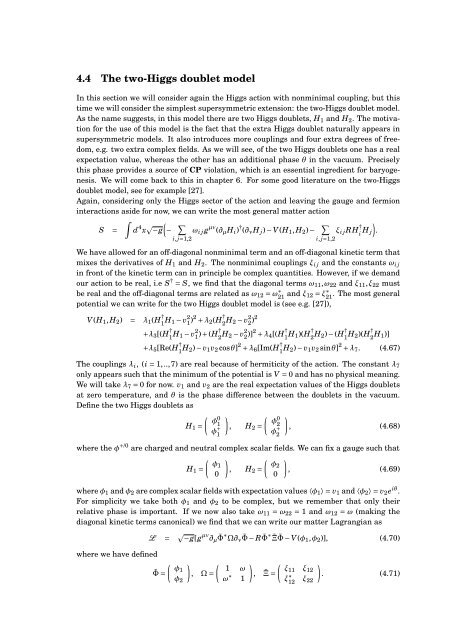Master's Thesis in Theoretical Physics - Universiteit Utrecht
Master's Thesis in Theoretical Physics - Universiteit Utrecht
Master's Thesis in Theoretical Physics - Universiteit Utrecht
Create successful ePaper yourself
Turn your PDF publications into a flip-book with our unique Google optimized e-Paper software.
4.4 The two-Higgs doublet modelIn this section we will consider aga<strong>in</strong> the Higgs action with nonm<strong>in</strong>imal coupl<strong>in</strong>g, but thistime we will consider the simplest supersymmetric extension: the two-Higgs doublet model.As the name suggests, <strong>in</strong> this model there are two Higgs doublets, H 1 and H 2 . The motivationfor the use of this model is the fact that the extra Higgs doublet naturally appears <strong>in</strong>supersymmetric models. It also <strong>in</strong>troduces more coupl<strong>in</strong>gs and four extra degrees of freedom,e.g. two extra complex fields. As we will see, of the two Higgs doublets one has a realexpectation value, whereas the other has an additional phase θ <strong>in</strong> the vacuum. Preciselythis phase provides a source of CP violation, which is an essential <strong>in</strong>gredient for baryogenesis.We will come back to this <strong>in</strong> chapter 6. For some good literature on the two-Higgsdoublet model, see for example [27].Aga<strong>in</strong>, consider<strong>in</strong>g only the Higgs sector of the action and leav<strong>in</strong>g the gauge and fermion<strong>in</strong>teractions aside for now, we can write the most general matter action∫S = d 4 x −g(− ∑ω i j g µν (∂ µ H i ) † (∂ ν H j ) − V (H 1 , H 2 ) −∑)ξ i j RH † i H j .i, j=1,2i, j=1,2We have allowed for an off-diagonal nonm<strong>in</strong>imal term and an off-diagonal k<strong>in</strong>etic term thatmixes the derivatives of H 1 and H 2 . The nonm<strong>in</strong>imal coupl<strong>in</strong>gs ξ i j and the constants ω i j<strong>in</strong> front of the k<strong>in</strong>etic term can <strong>in</strong> pr<strong>in</strong>ciple be complex quantities. However, if we demandour action to be real, i.e S † = S, we f<strong>in</strong>d that the diagonal terms ω 11 ,ω 22 and ξ 11 ,ξ 22 mustbe real and the off-diagonal terms are related as ω 12 = ω ∗ 21 and ξ 12 = ξ ∗ 21. The most generalpotential we can write for the two Higgs doublet model is (see e.g. [27]),V (H 1 , H 2 ) = λ 1 (H † 1 H 1 − v 2 1 )2 + λ 2 (H † 2 H 2 − v 2 2 )2+λ 3 [(H † 1 H 1 − v 2 1 ) + (H† 2 H 2 − v 2 2 )]2 + λ 4 [(H † 1 H 1)(H † 2 H 2) − (H † 1 H 2)(H † 2 H 1)]+λ 5 [Re(H † 1 H 2) − v 1 v 2 cosθ] 2 + λ 6 [Im(H † 1 H 2) − v 1 v 2 s<strong>in</strong>θ] 2 + λ 7 . (4.67)The coupl<strong>in</strong>gs λ i , (i = 1,..,7) are real because of hermiticity of the action. The constant λ 7only appears such that the m<strong>in</strong>imum of the potential is V = 0 and has no physical mean<strong>in</strong>g.We will take λ 7 = 0 for now. v 1 and v 2 are the real expectation values of the Higgs doubletsat zero temperature, and θ is the phase difference between the doublets <strong>in</strong> the vacuum.Def<strong>in</strong>e the two Higgs doublets asH 1 =( φ01φ + 1), H 2 =( φ02φ + 2), (4.68)where the φ +/0 are charged and neutral complex scalar fields. We can fix a gauge such that( ) ( )φ1φ2H 1 = , H02 = , (4.69)0where φ 1 and φ 2 are complex scalar fields with expectation values 〈φ 1 〉 = v 1 and 〈φ 2 〉 = v 2 e iθ .For simplicity we take both φ 1 and φ 2 to be complex, but we remember that only theirrelative phase is important. If we now also take ω 11 = ω 22 = 1 and ω 12 = ω (mak<strong>in</strong>g thediagonal k<strong>in</strong>etic terms canonical) we f<strong>in</strong>d that we can write our matter Lagrangian asL = −g[g µν ∂ µ ˜Φ ∗ Ω∂ ν ˜Φ − R ˜Φ ∗ ˜Ξ ˜Φ − V (φ 1 ,φ 2 )], (4.70)where we have def<strong>in</strong>ed( ) (φ11 ω˜Φ = , Ω =φ 2 ω ∗ 1) ( )ξ11 ξ 12, ˜Ξ =ξ ∗ . (4.71)12ξ 22
















